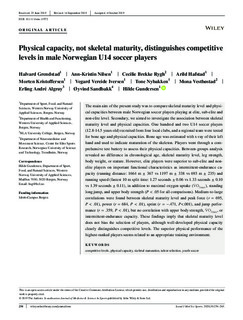| dc.contributor.author | Grendstad, Halvard Nikolai | |
| dc.contributor.author | Nilsen, Ann-Kristin | |
| dc.contributor.author | Rygh, Cecilie Brekke | |
| dc.contributor.author | Hafstad, Arild | |
| dc.contributor.author | Kristoffersen, Morten | |
| dc.contributor.author | Iversen, Vegard Vereide | |
| dc.contributor.author | Nybakken, Tone | |
| dc.contributor.author | Vestbøstad, Mona | |
| dc.contributor.author | Algrøy, Erling Andre | |
| dc.contributor.author | Sandbakk, Øyvind | |
| dc.contributor.author | Gundersen, Hilde | |
| dc.date.accessioned | 2020-03-05T08:32:45Z | |
| dc.date.available | 2020-03-05T08:32:45Z | |
| dc.date.created | 2019-10-17T13:41:04Z | |
| dc.date.issued | 2019 | |
| dc.identifier.citation | Scandinavian Journal of Medicine & Science in Sports. 2019, 30 (2), 254-263. | nb_NO |
| dc.identifier.issn | 0905-7188 | |
| dc.identifier.uri | http://hdl.handle.net/11250/2645392 | |
| dc.description.abstract | The main aim of the present study was to compare skeletal maturity level and physi-cal capacities between male Norwegian soccer players playing at elite, sub-elite and non-elite level. Secondary, we aimed to investigate the association between skeletal maturity level and physical capacities. One hundred and two U14 soccer players (12.8-14.5 years old) recruited from four local clubs, and a regional team were tested for bone age and physical capacities. Bone age was estimated with x-ray of their left hand and used to indicate maturation of the skeleton. Players went through a com-prehensive test battery to assess their physical capacities. Between-groups analysis revealed no difference in chronological age, skeletal maturity level, leg strength, body weight, or stature. However, elite players were superior to sub-elite and non-elite players on important functional characteristics as intermittent-endurance ca-pacity (running distance: 1664 m ± 367 vs 1197 m ± 338 vs 693 m ± 235) and running speed (fastest 10 m split time: 1.27 seconds ± 0.06 vs 1.33 seconds ± 0.10 vs 1.39 seconds ± 0.11), in addition to maximal oxygen uptake (̇VO2max), standing long jump, and upper body strength (P < .05 for all comparisons). Medium-to-large correlations were found between skeletal maturity level and peak force (r = 695, P < .01), power (r = 684, P < .01), sprint (r = −.471, P<.001), and jump perfor-mance (r = .359, P < .01), but no correlation with upper body strength, ̇VO2max, or intermittent-endurance capacity. These findings imply that skeletal maturity level does not bias the selection of players, although well-developed physical capacity clearly distinguishes competitive levels. The superior physical performance of the highest-ranked players seems related to an appropriate training environment. | nb_NO |
| dc.language.iso | eng | nb_NO |
| dc.publisher | Wiley | nb_NO |
| dc.rights | Navngivelse 4.0 Internasjonal | * |
| dc.rights.uri | http://creativecommons.org/licenses/by/4.0/deed.no | * |
| dc.title | Physical capacity, not skeletal maturity, distinguishes competitive levels in male Norwegian U14 players | nb_NO |
| dc.type | Journal article | nb_NO |
| dc.type | Peer reviewed | nb_NO |
| dc.description.version | publishedVersion | nb_NO |
| dc.source.pagenumber | 254-263 | nb_NO |
| dc.source.volume | 30 | nb_NO |
| dc.source.journal | Scandinavian Journal of Medicine & Science in Sports | nb_NO |
| dc.source.issue | 2 | nb_NO |
| dc.identifier.doi | 10.1111/sms.13572 | |
| dc.identifier.cristin | 1738001 | |
| dc.description.localcode | © 2019 The Authors. Scandinavian Journal of Medicine & Science In Sports published by John Wiley & Sons Ltd. This is an open access article under the terms of the Creative Commons Attribution License, which permits use, distribution and reproduction in any medium, provided the original work is properly cited. | nb_NO |
| cristin.unitcode | 194,65,30,0 | |
| cristin.unitname | Institutt for nevromedisin og bevegelsesvitenskap | |
| cristin.ispublished | true | |
| cristin.fulltext | original | |
| cristin.qualitycode | 2 | |

